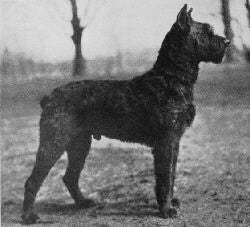Lange bevor die meisten Rassen, die wir heute kennen, als eine bestimmte Rasse registriert wurden, wurden sie bereits mit anderen Rassen gemischt und gekreuzt, um einen perfekten Hund zu finden, der die vom Züchter geforderten Aufgaben erfüllen konnte. Ja, das waren alles Arbeitshunde mit einer bestimmten Aufgabe im Sinn!
Um dies zu erreichen, musste der Hund sportlich und beweglich sein, selbständig denken können und ein Fell haben, das praktisch ist und ihm hilft, mit allem fertig zu werden, was die Natur ihm bietet. Das heißt nicht nur vor dem Wetter, sondern auch vor dornigen Sträuchern oder Angriffen durch andere Tiere.
Als diese Arbeitshunde in den Ausstellungsring kamen, begannen sich das Fell und die Hunde etwas zu verändern, wobei einige Rassen stärker überzüchtet wurden als andere. Heute haben wir Felle, die für einen Arbeitshund einfach nicht mehr praktisch sind. Ich weiß, die meisten von ihnen sind keine Arbeitshunde mehr, aber sie sind in den meisten Fällen auch keine Ausstellungshunde.
Einige Menschen haben einen Hund mit einem Übermaß an Haaren, das nicht nur für den Hund, sondern auch für die meisten Besitzer ein Hindernis darstellt!
Sie werden immer noch durch diese überzüchteten Felle behindert, in denen sie heute herumlaufen müssen, und das alles nur zur Freude der Zuschauer!
Scottish Terrier
Scotties were originally bred to hunt and kill vermin on farms and to hunt badgers and foxes in the Highlands of Scotland.
The actual origin of a breed as old as the Scottish Terrier is obscure and undocumented but the first written records about a dog of similar description to the Scottish Terrier dates from 1436.
Scotland’s landscape is a rough terrain in many areas with an extremely harsh climate. The Scottish Terrier was established to deal with hunting in such a landscape and climate. This is a tenacious hunter of vermin, foxes and badgers and was happy to go to ground to hunt. It was an athletic breed that could move quickly over the ground and had a harsh wire coat and a thick soft undercoat keeping him warm and dry. The modern day Scottish Terrier is not quite the terrier of yesteryear with shorter legs and a longer coat making him less capable than the Scottish terriers of 100 years ago.
West Highland Terrier
Airedale Terrier
Wire Fox Terrier
Welsh Terrier
Norwich Terrier
Lakeland Terrier
Lakeland in 1888. Working Lakeland today. Purebred Lakeland Today
Lakeland terriers are tough little working dogs that were bred to run all day and in all weather conditions. The Lakeland Terriers were originally bred in the harsh but beautiful countryside of the English Lake District to hunt foxes. The purpose of the Hunt was to destroy the fox that would prey on sheep and lambs thereby affecting the livelihood of those dependent upon farming. They belong to a genre of hunting dogs called Fell Breeds! (Fell = Hilly Landscape) These dogs are able to withstand the very harsh weather conditions typical of the area thanks to their very thick undercoat and wire coat.
Like many terrier breeds they have been mixed and matched with other terriers to become the terrier they are today which is a long legged narrow framed terrier that can get about quickly in the rocks and crags of the Lake District. Unfortunately the purebred show Lakeland terrier of today generally has a poorer coat quality than the working line of Lakeland.






























